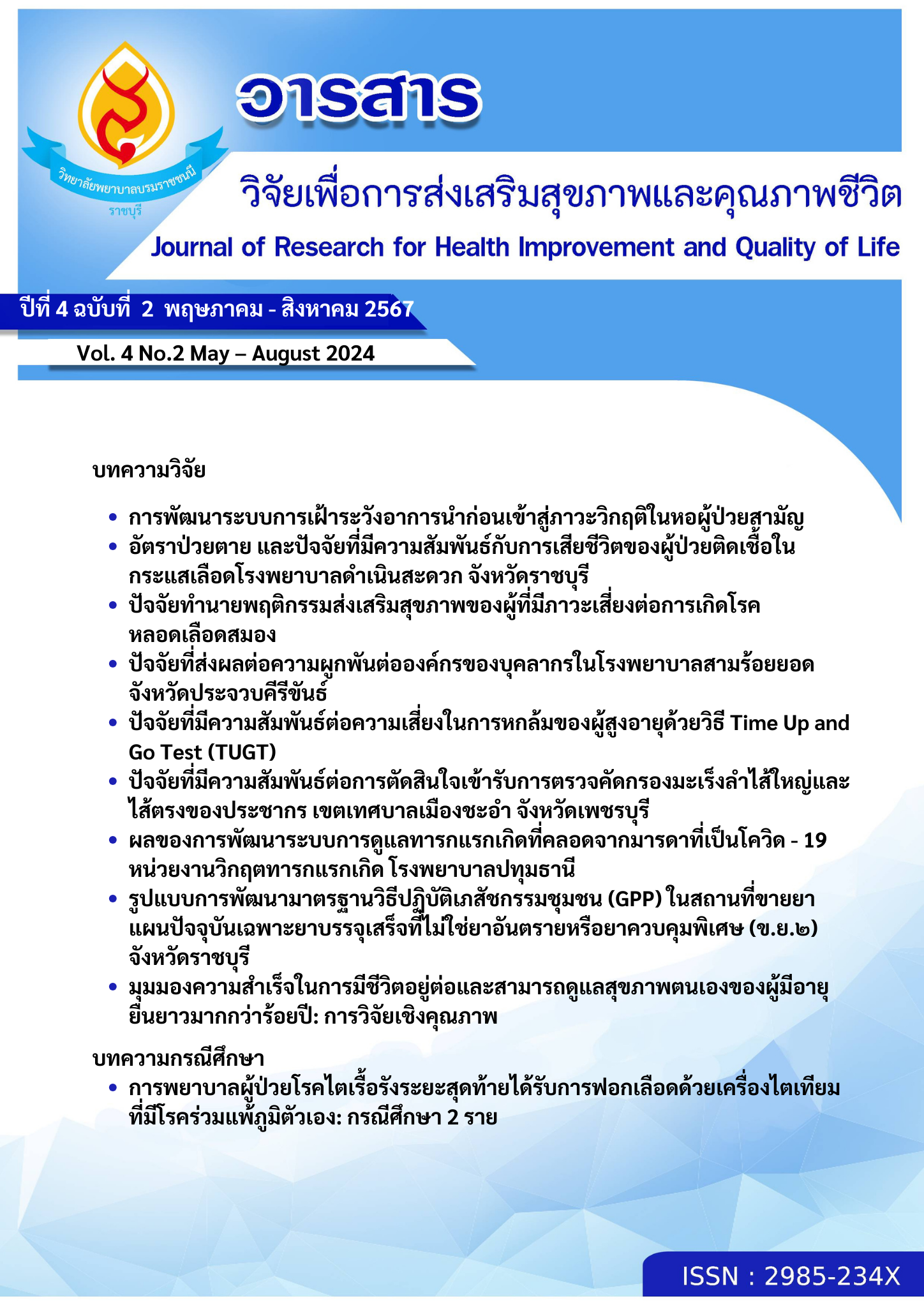ปัจจัยที่มีความสัมพันธ์ต่อความเสี่ยงในการหกล้มของผู้สูงอายุด้วยวิธี Time Up and Go Test (TUGT)
คำสำคัญ:
ผู้สูงอายุ, ความเสี่ยงในการหกล้ม, การทดสอบ Time Up and Go Testบทคัดย่อ
การวิจัยเชิงพรรณนานี้มีวัตถุประสงค์เพื่อ 1) ประเมินความเสี่ยงในการหกล้มของผู้สูงอายุ และ 2) ศึกษาปัจจัยที่มีความสัมพันธ์กับความเสี่ยงในการหกล้มของผู้สูงอายุด้วยวิธี Time Up and Go Test ใช้แบบสอบถามเก็บข้อมูลและแบบทดสอบ Time Up and Go Test กับกลุ่มตัวอย่างผู้สูงอายุที่มีอายุ 60 ปีขึ้นไป จำนวน 83 คน วิเคราะห์ข้อมูลโดยใช้ สถิติเชิงพรรณนา ประกอบด้วย ค่าเฉลี่ย ร้อยละ ส่วนเบี่ยงเบนมาตรฐาน ทดสอบสมมติฐานด้วยค่าไคสแควร์ และ Fisher’s exact test กำหนดระดับความเชื่อมั่น 95% ผลการศึกษา พบว่า
1. ผู้สูงอายุ 60 – 74 ปี ส่วนใหญ่มีความเสี่ยงในการหกล้ม (ร้อยละ 53.01) มากกว่าผู้สูงอายุ 75 ปีขี้นไป (ร้อยละ 8.43) และเพศหญิงมีความเสี่ยงต่อการหกล้มมากกว่าเพศชาย
2. ปัจจัยส่วนบุคคล ได้แก่ อายุ และปัจจัยร่วม ได้แก่ ปัญหาการเคลื่อนไหวลุกจากเตียง การแต่งกาย และความสูงของส้นรองเท้ามีความสัมพันธ์กับความเสี่ยงในการหกล้มด้วยวิธี Time Up and Go Test อย่างมีนัยสำคัญทางสถิติ (p < .05)
ดังนั้นหน่วยงานสาธารณสุข ควรประเมินความเสี่ยงในการหกล้มของผู้สูงอายุด้วยวิธี Time Up and Go Test และส่งเสริมให้ผู้สูงอายุมีความรู้ในการป้องกันการพลัดตกหกล้ม ส่งเสริมการออกกำลังกาย เพื่อยืดเหยียดให้กล้ามเนื้อส่วนต่างๆของร่างกายแข็งแรงมากขึ้นและแนะนำให้ใส่รองเท้าที่มีส้นสูงไม่มาก
เอกสารอ้างอิง
Chutima, C. (2014). Screen for falls with the Timed Up and Go Test (TUG). Journal of Medical Technology and Physical Therapy, 26(1), 5-16. (in Thai)
Department of Disease Control. (2022). Injury prevention .Information on falls (W00 - W19) in elderly people aged 60 years and over. https://ddc.moph.go.th/dip/news.php?news=23567&deptcode. (in Thai)
Department of Elderly Affairs. (2023). Situation of Thai elderly 2022. https://thaitgri.org/?wpdmpro= Annual situation report. (in Thai)
Health Systems Research Institute. (2021). Report on the Thai people's health survey by physical examination, No. 6, 2019 - 2020. https://kb.hsri.or.th/dspace/handle/11228/5425. (in Thai)
Kado, D. M., & Slater, D. (2014). Falls & Mobility Disorders. http://accessmedicine.mhmedical.com/content.aspx?bookid=953& Sectionid=53375649
Kane, R. L., Ouslander, J. G., Abrass, I. B., & Resnick, B. (2013). Chapter 10. Immobility. http://accessmedicine.mhmedical.com/content.aspx?bookid=678&Sectionid=44833888.
National Statistical Office. (2022). Executive Summary of the Survey of the Elderly Population in Thailand 2021. http://dop.go.th/dowload/knowledge/th1687612748-2406_0.pdf. (in Thai)
Nipa, S., & Lawitra, K.. (2020). Forecast of falls among elderly people (aged 60 years and over) in Thailand, 2017 - 2021. Bureau of Noncommunicable Diseases, Department of Disease Control, Ministry of Public Health. (in Thai)
Phutthipong, P., Winat, D., Arunrat, S., & Maithip, S. (2018). The Optimal Cut-Off Score of the Dynamic Balance Test for Predict Risk of Falls in Community-Dwelling Older Adults. Srinagarind Medical Journal, 33(4), 334-338. (in Thai)
Pimwarin, L. (2008). Factors that predict the occurrence of falls in the elderly. Master thesis, Faculty of Nursing, Thammasat University, Thailand. (in Thai)
Pornthip, T. (2019). Ergonomically correct toilet seat height for the elderly Doctor of Philosophy in Medical Engineering, Faculty of Engineering, Thammasat University, Thailand. (in Thai)
Premkamon, S. (2007). Factors related to falls among elderly people living in the community. Master thesis, Public Health, Khon Kaen University, Thailand. (in Thai)
Wipawee, K., Niphat, K.,& Suphasit, P. (2006). Risk factors that are Relationship to falls among elderly people in the community. Journal of Public Health, 15(5).787-799. (in Thai)
ดาวน์โหลด
เผยแพร่แล้ว
ฉบับ
ประเภทบทความ
สัญญาอนุญาต
ลิขสิทธิ์ (c) 2024 วิทยาลัยพยาบาลบรมราชชนนี ราชบุรี

อนุญาตภายใต้เงื่อนไข Creative Commons Attribution-NonCommercial-NoDerivatives 4.0 International License.
บทความทีตีพิมพ์ในวารสารนี้ถือว่าเป็นลิขสิทธิ์ของวิทยาลัยพยาบาลบรมราชชนนี ราชบุรี และผลงานวิชาการหรือวิจัยของคณะผู้เขียน ไม่ใช่ความคิดเห็นของบรรณาธิการหรือผู้จัดทํา




